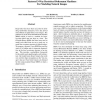Free Online Productivity Tools
i2Speak
i2Symbol
i2OCR
iTex2Img
iWeb2Print
iWeb2Shot
i2Type
iPdf2Split
iPdf2Merge
i2Bopomofo
i2Arabic
i2Style
i2Image
i2PDF
iLatex2Rtf
Sci2ools
101
Voted
JMLR
2010
2010
Factored 3-Way Restricted Boltzmann Machines For Modeling Natural Images
Deep belief nets have been successful in modeling handwritten characters, but it has proved more difficult to apply them to real images. The problem lies in the restricted Boltzmann machine (RBM) which is used as a module for learning deep belief nets one layer at a time. The Gaussian-Binary RBMs that have been used to model real-valued data are not a good way to model the covariance structure of natural images. We propose a factored 3-way RBM that uses the states of its hidden units to represent abnormalities in the local covariance structure of an image. This provides a probabilistic framework for the widely used simple/complex cell architecture. Our model learns binary features that work very well for object recognition on the "tiny images" data set. Even better features are obtained by then using standard binary RBM's to learn a deeper model.
| Added | 19 May 2011 |
| Updated | 19 May 2011 |
| Type | Journal |
| Year | 2010 |
| Where | JMLR |
| Authors | Marc'Aurelio Ranzato, Alex Krizhevsky, Geoffrey E. Hinton |
Comments (0)

